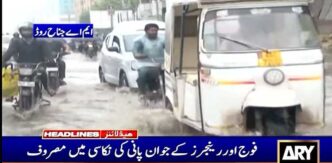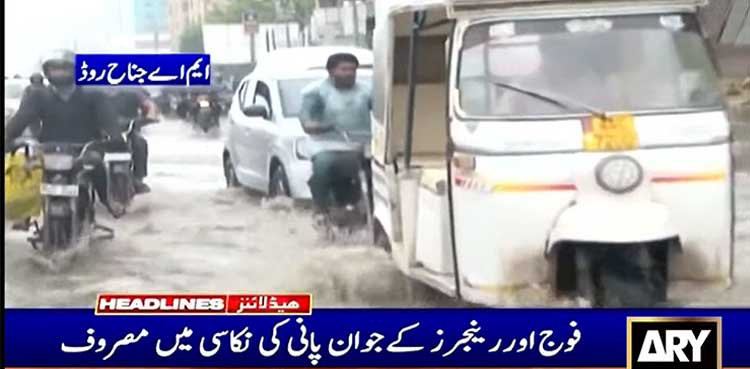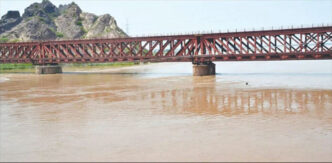Karachi Rain Chaos: Flooding and Traffic Disruptions Grip the City
KARACHI, SINDH – Heavy monsoon rains have plunged Karachi into chaos, triggering widespread urban flooding, traffic disruptions, and tragic incidents that have claimed lives and overwhelmed the city’s infrastructure. As of September 10, 2025, the port city of 20 million people remains grappling with the aftermath of relentless downpours, with key roads submerged, rivers overflowing, and rescue operations underway in severely affected neighborhoods .
🌧️ Current Rainfall Data and Impact
Record Rainfall:
Surjani Town received the highest rainfall at 129.6mm, followed by North Karachi (72mm), Korangi (71mm), and Defence Phase VII (70mm). Other areas like Gulshan-e-Hadeed and PAF Faisal Base recorded 69mm and 55mm, respectively .
Earlier, on September 9, Surjani Town saw 116mm of rain, exacerbating waterlogging and drainage challenges .
Fatalities and Rescue Operations:
At least seven deaths were reported in recent rain-related incidents, including electrocutions, wall collapses, and drownings. In Gadap Town, a van fell into the rain-filled Konkar Nadi, claiming three lives .
Rescue teams, including Edhi and Rescue 1122, evacuated over 350 people from inundated areas like Saadi Town, Essa Nagri, and Machhar Colony. Joint operations with the Pakistan Army rescued families trapped in Lassi Para and near Lyari River .
🚧 Infrastructure and Traffic Disruptions
Road Closures and Damage:
Korangi Causeway was shut due to strong currents from the Malir River, diverting traffic to Jam Sadiq Bridge and Qayyumabad .
Jehangir Road caved in near Teen Hatti due to faulty sewerage work, worsening traffic snarls. Other waterlogged spots included National Stadium, Civic Centre, and Shahrah-e-Faisal .
The Malir Expressway (under construction) suffered partial sinking, though officials denied structural breaches .
Traffic Diversion Plan:
Karachi Traffic Police declared Tariq Road a “No Parking Zone” to serve as an alternative route if Shahrah-e-Faisal floods. Commuters were advised to use routes like Sindhi Muslim Society, Stadium Road, and Lyari Expressway to avoid inundated areas .
Key diversion points included Power House Chowrangi to Nagan Chowrangi and routes from Defence to Airport via Shahrah-e-Bhutto .
🏞️ River Overflow and Urban Flooding
Lyari and Malir Rivers:
Both rivers swelled significantly, breaching banks at multiple points. The Malir River’s overflow inundated Korangi Causeway, while Lyari River flooded adjoining localities like Gulshan-e-Iqbal .
Thado Dam overflowed due to runoff from the Kirthar Range, sending torrents into Saadi Town and low-lying settlements .
Drainage System Failures:
Karachi’s natural stormwater drains (nullahs) are clogged by 20,000 tonnes of daily solid waste and encroachments, reducing their capacity and causing backflows .
Sindh Local Government Minister Saeed Ghani acknowledged challenges in removing encroachments due to legal hurdles .
🏛️ Government Response and Criticism
Official Actions:
Sindh Chief Minister Murad Ali Shah visited affected areas, ordering immediate drainage in Saadi Town and deploying 30 pumps across the city .
All educational institutions in Karachi Division were closed on September 9–10 due to rain forecasts .
Karachi Mayor Murtaza Wahab established four relief centers and mobilized rescue teams .
Political Accountability:
MQM-Pakistan convener Dr. Khalid Maqbool Siddiqui criticized the Sindh government’s “incompetence and negligence,” blaming encroachments along nullahs and corrupt practices for the crisis .
CM Shah refuted rumors of expressway breaches, urging public cooperation and denying structural failures .
📉 Underlying Causes and Climate Context
Climate Change Amplification:
Intensified monsoon rainfall patterns, driven by climate change, have increased the frequency of extreme precipitation events. Karachi’s rapid urbanization and inadequate drainage infrastructure exacerbate flooding risks .
Pakistan, responsible for <1% of global greenhouse emissions, bears disproportionate climate impacts, as noted by experts like Dr. Fahad Saeed .
Urbanization and Encroachments:
Unplanned urban growth has reduced natural drainage, while informal settlements along nullahs use these channels for sewage disposal, worsening blockages .
Laws like the Sindh River Protection Act are poorly enforced due to cultural and economic constraints, leaving vulnerable communities at risk .
🔮 Outlook and Recommendations
Immediate Measures:
Enhanced Drainage: Clear nullahs year-round, not just pre-monsoon, and install additional pumps in low-lying areas .
Early Warnings: Improve PMD’s localised forecasting and community alerts via sirens or SMS, especially for cloudburst-prone zones .
Long-Term Solutions:
Green Infrastructure: Invest in permeable pavements, rain gardens, and wetland restoration to absorb runoff .
Resettlement Plans: Provide alternative housing for nullah-side communities and enforce building regulations strictly .
💎 Conclusion
Karachi’s rain-induced chaos underscores a chronic governance crisis compounded by climate vulnerabilities. While immediate rescue and drainage efforts are underway, sustainable solutions require integrated urban planning, climate-resilient infrastructure, and political will to address entrenched issues. As the PMD predicts more showers, coordinated action between federal, provincial, and local authorities is essential to prevent further loss of life and economic damage







